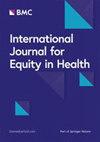Social cure model: testing the link between identity centrality and body appreciation in diverse sexual orientation and gender identity groups
IF 4.1
2区 医学
Q1 PUBLIC, ENVIRONMENTAL & OCCUPATIONAL HEALTH
引用次数: 0
Abstract
The level of experienced sociocultural pressure to have an idealized body can vary depending on a person’s gender identity and sexual orientation. The current study explored whether differences in levels of body appreciation among people with different sexual orientations and gender identities vary because of differing levels of experienced pressure by in-group members and varying levels of experienced hostile behaviors because of their looks or body. Thereby, the study tests the social cure model, according to which high levels of identity centrality are associated with better mental health. An online cross-sectional questionnaire study was conducted with 1,587 people (51.3% cisgender women, 39.3% cisgender men, 9.5% non-binary; 52.9% identified as heterosexual, 27.7% identified as bisexual/pansexual, 11.2% identified as gay/lesbian, 8.2% identified as asexual/demi/queer; Mage = 32.9, SD = 12.6) from German-speaking countries. Variables were assessed with German-language versions of the Multidimensional and Multicomponent Measure of Social Identification, Body Appreciation Scale-2, the Perceived Stigmatization Questionnaire, and the Sociocultural Attitudes Towards Appearance Questionnaire-4, revised. A manifest-path model was calculated. Non-binary persons reported lower levels of body appreciation than did cisgender men and sexual minority persons reported lower levels of body appreciation than did heterosexual persons. Furthermore, sexual minority persons experienced more hostile behaviors directed towards them because of their looks or body than did heterosexual persons. Similarly, non-binary persons experienced more hostile behaviors than did men. Non-binary persons were subjected to lower levels of in-group pressure than were men. Gay/lesbian persons and asexual persons were subjected to lower levels of in-group pressure than were heterosexual persons. More hostile behaviors and stronger in-group pressure were related to lower body appreciation. In cisgender women and men indirect links revealed associations between strong identity centrality and low levels of body appreciation through the mediator of high in-group pressure. Data in sexual minority individuals or non-binary persons supported the social cure model, according to which persons can find support and validation for their looks and body from in-group members. In cisgender women and men, strong identification as a woman or man can be related to stronger in-group pressure and in turn to lower body appreciation.社会治愈模式:测试不同性取向和性别认同群体的身份中心性与身体鉴赏之间的联系
一个人的性别认同和性取向不同,其所承受的拥有理想化身材的社会文化压力也会不同。本研究探讨了不同性取向和性别认同的人在身体欣赏水平上的差异是否会因群体内成员施加压力的程度不同以及因长相或身体而遭受敌对行为的程度不同而不同。因此,该研究检验了社会治愈模型,根据该模型,高水平的身份中心性与更好的心理健康相关。我们对来自德语国家的 1587 人(51.3% 为顺性女性,39.3% 为顺性男性,9.5% 为非二元性;52.9% 为异性恋,27.7% 为双性恋/泛双性恋,11.2% 为同性恋/女同性恋,8.2% 为无性/半无性/同性恋;Mage = 32.9,SD = 12.6)进行了在线横截面问卷调查。研究人员使用德语版的社会认同多维和多成分测量表、身体鉴赏量表-2、感知鄙视问卷和社会文化外貌态度问卷-4(修订版)对各变量进行了评估。计算出了一个表现路径模型。非二元性别者对身体的欣赏水平低于顺性别男性,性少数群体者对身体的欣赏水平低于异性恋者。此外,与异性恋者相比,性少数群体的人因其长相或身体而遭受的敌意行为更多。同样,与男性相比,非二元人士遭受了更多的敌意行为。与男性相比,非二元人受到的群体内压力较低。同性恋者和无性恋者受到的群体内压力低于异性恋者。更多的敌对行为和更强的群体内压力与较低的身体欣赏水平有关。在双性恋女性和男性中,间接联系显示,通过高群体内压力这一中介,强身份中心性与低身体欣赏水平之间存在关联。性少数群体或非二元人群的数据支持社会治愈模式,根据该模式,人们可以从群体内成员那里找到对其容貌和身体的支持和肯定。在顺性别女性和男性中,强烈的女性或男性身份认同可能与较强的群体内压力有关,进而与较低的身体鉴赏力有关。
本文章由计算机程序翻译,如有差异,请以英文原文为准。
求助全文
约1分钟内获得全文
求助全文
来源期刊

International Journal for Equity in Health
Medicine-Health Policy
CiteScore
7.80
自引率
4.20%
发文量
162
审稿时长
28 weeks
期刊介绍:
International Journal for Equity in Health is an Open Access, peer-reviewed, online journal presenting evidence relevant to the search for, and attainment of, equity in health across and within countries. International Journal for Equity in Health aims to improve the understanding of issues that influence the health of populations. This includes the discussion of political, policy-related, economic, social and health services-related influences, particularly with regard to systematic differences in distributions of one or more aspects of health in population groups defined demographically, geographically, or socially.
 求助内容:
求助内容: 应助结果提醒方式:
应助结果提醒方式:


